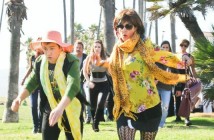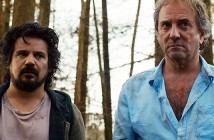
Cast: Henry Cavill, Amy Adams, Michael Shannon
Director: Zack Snyder
Country: USA | Canada | UK
Genre: Action | Adventure | Fantasy | Sci-Fi
Official Trailer: Here
Editor’s Note Man of Steel opens in wide release on Friday, June 14th
It’s been 26 years since we last saw Superman punch a guy on the big screen. The sole attempt to bring back the last son of Krytpon since Christopher Reeve last wore the red cape, 2006’s cringe-inducing Superman Returns, saw Supes battling his greatest nemesis yet: an inanimate chunk of rock. That anti-climax is perhaps the greatest of the reasons that film, and the Superman brand, has suffered so hugely in the public consciousness. Rebooted here with the explosive verve of a Zach Snyder movie, this take on the Superman myth satisfies both those who crave faster-than-a-speeding-bullet aerial fistfight-ery and those who like their Christ allegories with really good hair.
Superman Returns hammered home its Christ metaphor with Superman descending from the sky, resurrected, in cruciform pose. Man of Steel attempts to one-up it, recreating that divine posture—although at a less pivotal moment—and even having a scene where Clark Kent soul-searches in a church, haloed by stained glass. But it’s actually a lot cleverer than this. Clark, born Kal-El, is planet Krypton’s equivalent of the Virgin Birth, a child born through natural reproduction on a dying planet where kids have been eugenixed in Matrix-like pods for generations. Even before the planet crumbles due to the hubris of its ruling elite, Kal-El is already the last hope for his people. As the fascist General Zod (Michael Shannon) mounts a coup, Kal-El’s father Jor-El (an exceptionally enthusiastic Russell Crowe) embarks on a quest to preserve the history of his people, showing the sort of physicality that escaped Marlon Brando back in 1978. The “Codex” of the Kryptonian people is retrieved and launched into space with the miracle child, just as Zod’s rebellion is brought to a close and the planet devours itself in a bowl of lava-Os.
After this extended introduction to this slightly different take on the Superman origin, David S. Goyer’s screenplay eschews the chronological tracing of the early years of Jor-El’s life as Clark Kent, of Smallville, Kansas, in favour of cutting to his Bruce Wayne-like journey of self-discovery, helping those in need across America with less than sufficient subtlety for the only alien on Earth. In moments of reflection Clark thinks back to suitable lessons from his youth, the calming tone of his mother Martha (a finely aged Diane Lane) and the baseball coach morality of his father Jonathan (Kevin Costner, back with a very calm and insightful vengeance). The intercutting flashbacks allow us to get to Clark’s discovery of who he is more quickly, uncovering a lost Kryptonian craft hidden in the Arctic and downloading his birth father’s memories, giving Crowe considerably more—and welcome—screen time. Soon he is wearing the old blue, red and bit o’ yellow and blasting around the planet like he owns the place. But crafty reporter Lois Lane (Amy Adams) is on the trail of this super-human do-gooder, and a vengeful General Zod emerges from the shadows of space searching for the Codex and the son of Jor-El.
Rebooted here with the explosive verve of a Zach Snyder movie, this take on the Superman myth satisfies both those who crave faster-than-a-speeding-bullet aerial fistfight-ery and those who like their Christ allegories with really good hair.
 Snyder, a filmmaker whose hitting and missing along the years have never allowed critics to deny his ambition and flair, shows remarkable restraint here, choosing to focus on the scale of the world(s) his story is set in instead of drawing all attention to action and movement; there is not a moment of his signature slow-down/speed-up style of editing, allowing the super-powered Kryptonians to blast around the screen at their own dizzying speeds. The scenes on Krypton could rival Avatar for sheer scale of world-building, while the flashbacks to Kansas are filmed with the tenderness and tone of an Oscar-nominated coming-of-age tale: the director of 300 shooting like Richard Linklater meets Terrence Malick. Who’d have seen it coming?
Snyder, a filmmaker whose hitting and missing along the years have never allowed critics to deny his ambition and flair, shows remarkable restraint here, choosing to focus on the scale of the world(s) his story is set in instead of drawing all attention to action and movement; there is not a moment of his signature slow-down/speed-up style of editing, allowing the super-powered Kryptonians to blast around the screen at their own dizzying speeds. The scenes on Krypton could rival Avatar for sheer scale of world-building, while the flashbacks to Kansas are filmed with the tenderness and tone of an Oscar-nominated coming-of-age tale: the director of 300 shooting like Richard Linklater meets Terrence Malick. Who’d have seen it coming?
The story is well-known, though there are a few new beats to this drum. Superman is unknown to the people before Zod and his army arrive. Lois is on to the son of Jor-El long before she meets Clark. Kryptonite and Lex Luthor play no part in the tale, although the latter’s industrial might is evident in one scene. A new extreme take on the life lessons Jonathan Kent teaches Clark provides one of the film’s most affecting scenes. The action and drama are updated suitably, and there are some clever allusions to the world of today, with Superman in one scene forced to down a military drone sent to track his location. But the failure to properly evolve the Daily Planet, the “newspaper” of record, seems like both a missed opportunity and a cop-out. The internet is briefly mentioned as an alternative means to break a story, but there is no feel for the crisis in the industry. The scenes in the Daily Planet offices feel terribly dated, with even the layout of the newsroom floor looking like it’s from the 1970s. As if struck by a magic beam fired by some politically correct supervillian, editor Perry White is now black and Jimmy Olsen is now Jenny—all good progressive things, if only the characters were given anything to do.
The script is both the salvation and damnation of Man of Steel. Goyer, whose finest work rests in The Dark Knight trilogy, created this story with producer Christopher Nolan, taking a break from bats. The Batman Begins structure of the early earthbound sequences revels in this reunion, and Goyer’s screenplay is superb at contrasting the patriarchs and the lessons they imbue upon their shared son. But the dialogue outside of these father/son scenes is often dull, and almost every last one of Goyer’s jokes falls sigh-worthily flat. One military character has an identical arc to a police character in The Dark Knight Rises, almost scene for scene. The burden of two enormous themes—what does it mean to be human? and; what does it mean to be the last of one’s kind?—proves too much for Goyer to balance, and by the end one of these questions has been all but completely dropped.
The carnage of the finale is unspeakable, and the presence of Transformers 3 DP Amir Mokri seems hardly a coincidence, with buildings crumbling and exploding all across Metropolis in a veritable blitzkrieg of CGI. It looks superb, but with Goyer choosing to focus on only three civilians throughout the colossal donnybrook there is little sense of human tragedy in what must be a ground zero of Nagasakian proportions.
 British actor Henry Cavill, following performances in The Tudors and Immortals, shows himself a strong leading man as the adult Clark Kent. Preposterously handsome, like TV Clark Kent Tom Welling but sculpted in marble, Cavill’s presence dominates when he is not pitched against the two Robin Hoods, who utterly steal the film. Cavill may not be given too many opportunities to show off his talents, but in the few scenes where it counts his face unleashes an intensity and pain that totally sell the moment. Amy Adams is less lucky as Lois, working with an awkwardly written version of the character, but still ever-believable as a successful female reporter. Zack Snyder, whose Sucker Punch has been the subject of more women’s studies PhDs than Sylvia Plath (FACT), refrains from making an obvious sex symbol out of Lois, keeping her professionally dressed throughout, and able to give as good as she gets in debate with even the most alpha male of men. If Goyer had been more successful in writing both her character and the love story between Lois and Clark, Adams could no doubt have stolen the show. Michael Shannon is similarly let down by lax characterisation, but his undeniable intensity makes him a riveting Hitler-esque Zod to Terence Stamp’s more Rasputiny take.
British actor Henry Cavill, following performances in The Tudors and Immortals, shows himself a strong leading man as the adult Clark Kent. Preposterously handsome, like TV Clark Kent Tom Welling but sculpted in marble, Cavill’s presence dominates when he is not pitched against the two Robin Hoods, who utterly steal the film. Cavill may not be given too many opportunities to show off his talents, but in the few scenes where it counts his face unleashes an intensity and pain that totally sell the moment. Amy Adams is less lucky as Lois, working with an awkwardly written version of the character, but still ever-believable as a successful female reporter. Zack Snyder, whose Sucker Punch has been the subject of more women’s studies PhDs than Sylvia Plath (FACT), refrains from making an obvious sex symbol out of Lois, keeping her professionally dressed throughout, and able to give as good as she gets in debate with even the most alpha male of men. If Goyer had been more successful in writing both her character and the love story between Lois and Clark, Adams could no doubt have stolen the show. Michael Shannon is similarly let down by lax characterisation, but his undeniable intensity makes him a riveting Hitler-esque Zod to Terence Stamp’s more Rasputiny take.
Hans Zimmer may be no John Williams, but his score rises at the most crucial moments and lingers in the ear with the same fire, if not the same bombast. This is a film with an almost faultless soundscape, and the sound effects on Krypton help sell it as both a believable world and society. The production design on Krypton is fantastic, with devices using Pin Art-style illustrations to communicate instead of video screens, and the costumes looking like Liberace-in-space, flamboyant but superbly detailed. This all brings us back to the action, because yes—indeed—Superman does punch someone in the face. Several times. For the most part Snyder conceives a remarkable, rocketing look to his action scenes, although the speed can be hard to follow. Clark’s first battle with the Kryptonians is thrilling but overstays its welcome, and the camera at times is more concerned with framing the logo of an IHOP than showing the fates of those thrown through its windows. A battle with a tentacled robot is a poorly edited and indecipherable mess, but the payoff is immense. A re-enactment of a major scene from Independence Day slips from homage into theft, and the film’s recurring usage of the fatal consequences of buttons being only half-pressed down is insulting to the audience.
The carnage of the finale is unspeakable, and the presence of Transformers 3 DP Amir Mokri seems hardly a coincidence, with buildings crumbling and exploding all across Metropolis in a veritable blitzkrieg of CGI. It looks superb, but with Goyer choosing to focus on only three civilians throughout the colossal donnybrook there is little sense of human tragedy in what must be a ground zero of Nagasakian proportions. The Avengers was far more concerned with the average citizen. Like the film itself, the action sequences are troubled, but overall satisfying. Snyder has not made the magisterial Superman film that people had hoped for, but he has made the most exciting take on the tale yet. Sequels will come, and the end earns them. But no scene is more deserving of a Superman franchise than that moment when Henry Cavill first takes to the skies, as if lifted by Zimmer’s score, and jets across the world, Snyder’s camera slamming from left to right, struggling to keep up with the superhero. It’s the cinematic moment the character has been craving since Action Comics #1. You won’t need to believe a man can fly; you’ll see it.
[notification type=”star”]70/100 ~ GOOD. Some tidy alterations to the Superman mythos justify this epic reboot. The middle dips in terms of drama and the focus on military characters over citizens of Smallville and Metropolis robs much of its heart, but this remains a thrilling adventure that looks and sounds astonishing from explosive start to explosive-er finish.[/notification]



